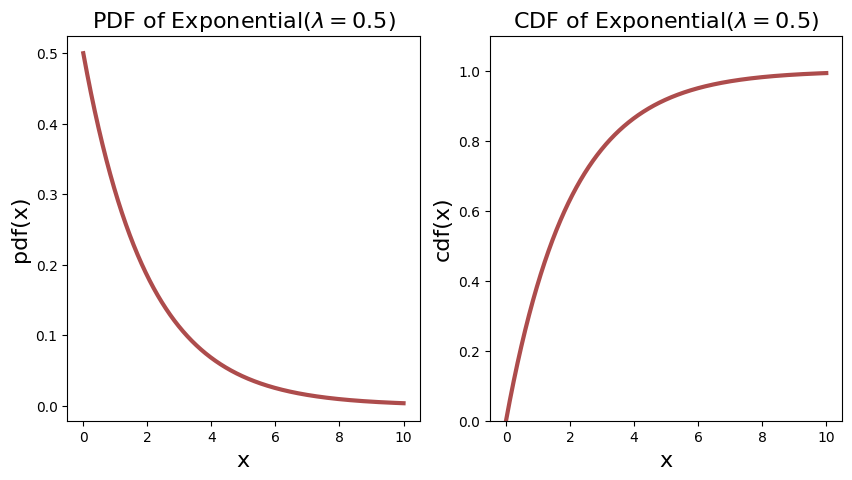Exponential Distribution
Contents
Exponential Distribution#
Definition#
Definition 52 (Exponential Distribution (PDF))
\(X\) is a continuous random variable with an exponential distribution if the probability density function is given by:
where \(\lambda > 0\) is the rate parameter (rate of decay).
Some conventions:
We write \(X \sim \exponential(\lambda)\) to indicate that \(X\) has an exponential distribution with rate parameter \(\lambda\).
Remark 4 (Exponential Distribution (PDF))
When \(\lambda = 0\), we have,
This means that \(\pdf(0)\) will be more than 1 if \(\lambda > 0\) [Chan, 2021].
Definition 53 (Exponential Distribution (CDF))
If \(X\) is a continuous random variable with an exponential distribution with rate parameter \(\lambda\), then the CDF is given by integrating the PDF defined in Definition 52:
The PDF and CDF of two exponential distributions are shown below.
1import sys
2from pathlib import Path
3parent_dir = str(Path().resolve().parent)
4sys.path.append(parent_dir)
5
6import numpy as np
7import scipy.stats as stats
8
9from utils import seed_all, plot_continuous_pdf_and_cdf
10seed_all()
11
12# x = np.linspace(0, 10, 5000)
13lambda_1, lambda_2 = 0.5, 2
14scale_1, scale_2 = 1 / lambda_1, 1 / lambda_2
15X1 = stats.expon(scale=scale_1)
16X2 = stats.expon(scale=scale_2)
17
18plot_continuous_pdf_and_cdf(X1, 0, 10, title="Exponential$(\lambda = 0.5)$")
19plot_continuous_pdf_and_cdf(X2, 0, 10, title="Exponential$(\lambda = 2)$")
Using Seed Number 1992


Expectation and Variance#
Theorem 14 (Expectation and Variance of Exponential Distribution)
If \(X\) is a continuous random variable with an exponential distribution with rate parameter \(\lambda\), then the expectation and variance are given by:
Further Readings#
Further readings is a must since Professor Chan give many intuition on how Exponential distribution is used in real life. He also showed how Exponential distribution is derived from the Poisson distribution.
Chan, Stanley H. “Chapter 4.5. Uniform and Exponential Random Variables.” In Introduction to Probability for Data Science, 205-211. Ann Arbor, Michigan: Michigan Publishing Services, 2021.
Pishro-Nik, Hossein. “Chapter 4.2.2. Exponential Distribution” In Introduction to Probability, Statistics, and Random Processes, 249-252. Kappa Research, 2014.


